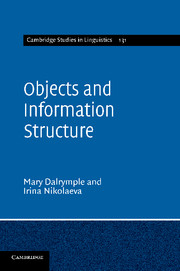Book contents
- Frontmatter
- Contents
- Preface and Acknowledgements
- List of Abbreviations
- 1 Introduction
- 2 Syntactic assumptions
- 3 Information structure in grammar
- 4 Syntax and information structure
- 5 Topicality and grammatical marking
- 6 Topical marking of nonsubjects
- 7 Topicality and DOM
- 8 Primary and secondary objecthood and DOM
- 9 Multiple objects and grammatical alignment
- 10 Semantic features, topicality and grammaticalisation
- 11 Conclusion
- References
- Author Index
- Language Index
- Subject Index
3 - Information structure in grammar
Published online by Cambridge University Press: 05 October 2012
- Frontmatter
- Contents
- Preface and Acknowledgements
- List of Abbreviations
- 1 Introduction
- 2 Syntactic assumptions
- 3 Information structure in grammar
- 4 Syntax and information structure
- 5 Topicality and grammatical marking
- 6 Topical marking of nonsubjects
- 7 Topicality and DOM
- 8 Primary and secondary objecthood and DOM
- 9 Multiple objects and grammatical alignment
- 10 Semantic features, topicality and grammaticalisation
- 11 Conclusion
- References
- Author Index
- Language Index
- Subject Index
Summary
Contemporary research on information structure addresses two main topics: the content of information structure, and the development of models of grammar which account for interactions among information structure, syntax, and semantics. This chapter briefly deals with the first topic. It is not our goal here to evaluate theories of information structure in detail (for thorough overviews, see Vallduví 1992 and Erteschik-Shir 2007). Instead, we offer some observations on how information-structure roles are defined in what we consider to be the most articulated and coherent views of information structure. The literature on information structure contains a plethora of terms that overlap but are used in different and conflicting ways, and so one of our main aims is to provide explicit working definitions and terms for the concepts which we will assume, which can be used in further analysis. The second question, the place of information structure in our theory of grammar, will be addressed in Chapter 4.
The content of information structure
We view exchange of information as the main function of language. Information structure is the level of sentence organisation which represents how the speaker structures the utterance in context in order to facilitate information exchange. Specifically, it indicates how the propositional content of an utterance fits the addressee's perceived state of knowledge at the time of utterance. In human communication, new information is normally added to the already existing store of knowledge in the addressee's mind.
- Type
- Chapter
- Information
- Objects and Information Structure , pp. 45 - 57Publisher: Cambridge University PressPrint publication year: 2011



